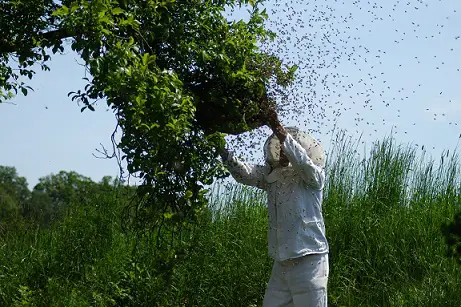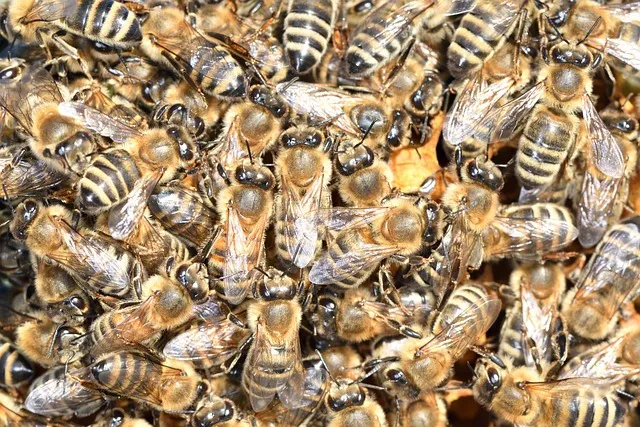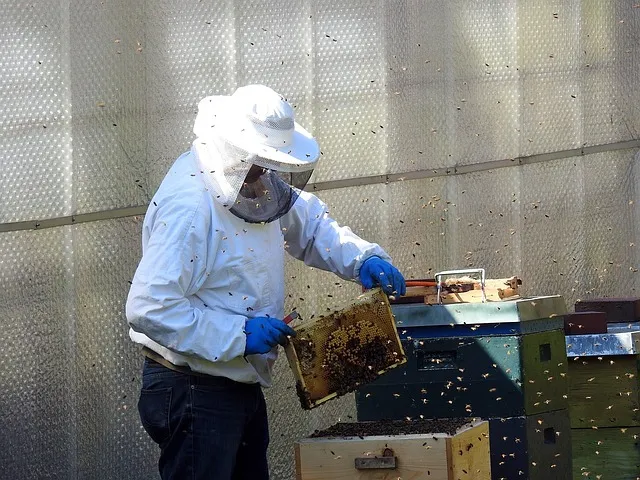What Does a Bee Sting Look Like the Next Day?
Honey bees give unique products that we enjoy, especially honey. However, when you meet these lovable creatures on the wrong side, they will give you a treat of the year. They usually guard their territories zealously and will sting when they feel threatened. On a foraging trip, a honeybee will rarely harm you unless you step on it or handle it roughly.
A bee sting is not pleasant; it can be really annoying. In most cases, the reaction is mild, and a home remedy may be all that you need. However, if you suffer numerous stings, you may require medical treatment. Again, people who are allergic to bee stings call for emergency treatment.
Similar Articles you may like to read –
What does a bee sting look like in the skin? How to remove it?
How to tell if your dog got stung by a bee?
How many bees can kill a human? if sting together
Why are beekeepers not stung?
What Does a Bee Sting Look like the Next Day?
The repercussions of a bee sting show right away. You will experience severe pain, itching, redness, and swelling. Depending on your treatment, the pain may disappear within hours. On the following day, the affected area will still be itchy, red, swollen, and maybe a bit painful for mild and moderate reactions. These symptoms may take another few days to clear up to seven days. However, the symptoms are more severe to allergic people since their entire body is affected.
This is What to Do When You Suffer From a Bee Sting
Stay Calm
Calm down to evade additional attacks. Surprisingly, due to the pheromones on the injected venom, it is easier for other bees to trace you and attack as well. Ensure you walk away quietly.
Remove the Stinger
Remove the stinger as soon as possible by scraping it off with a blunt object. You can use your fingernail. This prevents the venom from spreading further into your body. Even when the bee is gone, the stinger continues to inject poison into your body. A sharp object can burst the venom leading to worsening of symptoms.
Clean the Affected Place
Clean the stung area with water and soap to remove venom remains on the skin and minimize subsequent bacterial infection.
Apply a Cold Press
Applying a cold press will help to reduce the pain and swelling (body inflammatory response).
Take a Painkiller if Necessary
A pain reliever will help to ease the pain. To minimize the itching and swelling, you can apply an antihistamine cream or take an antihistamine tablet orally.
Home Remedies for Bee a Sting
There are many home remedies that you can use to treat a bee sting and speed up the healing process.
Ice
Applying an ice pack on the stung zone help to minimize pain and swelling
Aloe vera Gel
Aloe vera gel eases irritation of the stung area
Honey
Honey contains anti-inflammatory compounds and may reduce swelling
Baking Soda
It helps to counteract the bee venom
Apple Cider Vinegar
Help to reduce swelling
Tooth Paste
Alkaline substances in the toothpaste help to neutralize the venom
What Happens When a Bee Stings You?
For a honey bee to sting you, it injects its venomous sting into your skin. The venom contains active compounds( proteins and enzymes) that cause pain and cellular injury to your skin cells and affect your immune system. This is what causes swelling in the stung area.
As mentioned earlier, it is advisable to remove the sting right away since it continues to pump venom into your body.
How can you tell between a mild attack and an allergic reaction?
Only a tiny percentage of people experience these severe allergic reactions. These reactions can make a victim collapse and die within minutes to an hour hence requiring emergency action. A person who has been stung multiple times may also require medical assistance.
Symptoms include:
- Chest tightness
- Wheezing
- Tightness in the throat
- Nausea, diarrhea, and vomiting
- A reduced or rapid pulse
- Loss of consciousness
- Difficulty in breathing
- Skin reactions
- Passing out
- Break out of hives (Itchy and red rashes on the skin)
- Headache
- Pale skin
- Fever
- Swelling of tongue and lips
- Feeling of uneasiness
- Mild Reactions
- Redness on the Stung area and adjacent area
More articles you may like to read –
Does vinegar help with bees?
How to keep Honey Bees away from the pool
How to Identify Honey Bees? Honey Bee Identification Guide
How to get rid of Hives? On arm? Should it be removed Overnight?
Effects of Multiple Stings
Multiple stings can result when someone disrupts a swarm of bees or around a bee nest. When bees feel threatened, they fight back with stings for self-defense. The accumulation of venom from the stings triggers a toxic reaction in your body. Multiple stings can turn into an emergency case for people with breathing or heart problems, older people, and young children.
Don’ts of a Bee Sting
- Don’t squeeze the stinger as you remove it. It can cause more penetration of poison into your body.
- Don’t burst any blisters that may develop after to avoid infection
- Avoid using a sharp object while removing the sting.
What happens to the bee after stinging you?
Only a worker bee possesses a stinger. Once it stings you, the barbed stinger sticks and remains on your skin. This tears the bee’s lower body, and it later dies. In contrast, other stinging insects such as hornets, wasps, yellow jackets, carpenter bees don’t lose their sting after stinging. Their stingers are not barbed, and they can withdraw them easily.
How to Prevent Honey Bee Stings
The ideal way to avoid bee stings is to protect yourself from being stung. These are the precautions to take when around a bee’s territory.
- Refrain from wearing bright colors
- Avoid scented perfumes or sprays, especially those with fruity or floral scents.
- Don’t disturb them. Honey bees only sting when bothered.
- Wear shoes on the outdoors
- If you are allergic, you may consider keeping off from bee’s territories.
- If a bee is flying around where you are, remain calm. Don’t swat it or interfere with its business.
- Keep food and drinks covered when eating outdoors
- Apply insect repellants
FAQs
How do you know if a bee stinger is still on your skin?
Examine the affected area carefully. If present, you will see a small black dot.
What happens if l don’t remove the stinger?
Venom will continue to be released into your body which may worsen the symptoms and increase the chances of infection.
How do l know if l am allergic to bee stings?
If, after being stung, you suffer from fever, difficulty in breathing, hives, wheezing, swelling of the tongue, etc. You can as well do a medical check. Reactions differ among individuals.
How long does it take for the symptoms of a bee sting to disappear?
For mild reactions, it takes a few days up to 7 days. People with allergic reactions should seek professional help.
What do l apply to a bee sting?
After removing the stinger and cleaning the affected area, you can apply honey, aloe vera gel, toothpaste, apple cider vinegar, or essential oil.



